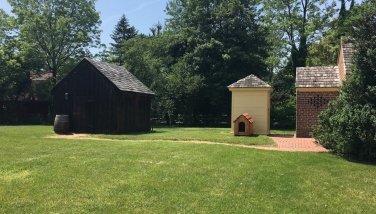Dog Days at the Wilson-Warner House
We have recently added a dog house to the landscape of the Wilson-Warner House, back by the outhouse. Why a dog house, you may ask? Records of the three-day Wilson bankruptcy sale held in March of 1829 were handed down from Mary Warner’s father, one of the executors of the Wilson estate, to her in the form of two ledgers. Examination of the ledger for March 29 revealed that two doghouses were among the items sold.
Although we do not know what breed of dog was kept in the Wilson dog houses, from the colonial era until the early 1900’s most family dogs were the descendants of a relatively narrow range of common types: spaniels, hounds, setters and pointers, rough and short coated terriers, mastiffs, newfoundlands and bulldogs as well as mixed breeds.
Dogs in Early America
Well-bred dogs were prized but were relatively uncommon except among the brotherhood of sport hunters where some dog owners worked diligently to maintain bloodlines. In the late 17th and early 19th centuries, working dogs were common in the Delmarva area—these dogs were used for hunting game and waterfowl, retrieving, pulling carts, vermin control and security. They lived most of their lives outdoors and dog houses were common features of house yards.
Come visit the Wilson-Warner to see our latest addition—it’s truly for the dogs!



